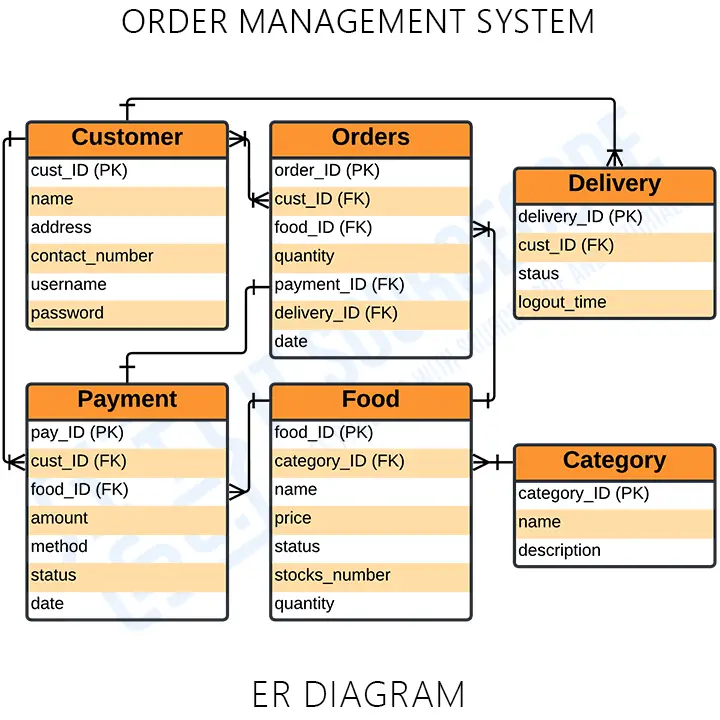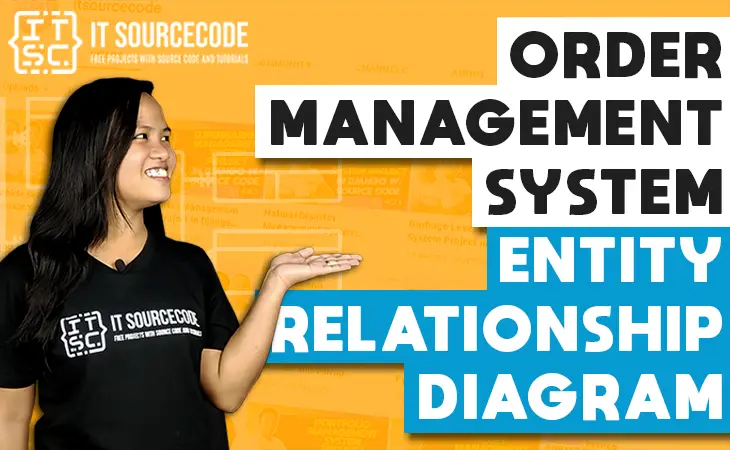The order management system ER Diagram reveals the relationships of its entities to form the project database design. This describes the logical structure of the system’s database or data storage. It is done by identifying the order process entities, their properties, and the interactions between them.
The database design is sketched out using order management system project ER diagrams. This database sketch becomes the actual basis of the system’s data storage that will serve as data destination and source.
Order Management System ER Diagram: Details
The table shows the overall description of the ER Diagram for Order Management System. It has a complete overview of the project’s information.
| Name: | Order Management System ER Diagram |
| Abstract: | The order management system ER diagram depicts the relationship between various entities. It can be thought of as a blueprint for your system (project) structure. |
| Diagram: | ER Diagram is also known as Entity Relationship Diagram |
| Tools Used: | Diagraming tools that provide ER diagram symbols. |
| Users: | Website, Applications, and Software. |
| Designer: | ITSourceCode.com |
What is an ER Diagram?
The ER Diagram also refers to the order management system database design. It is the graphical depiction of relationships between all the entities involved in the system. Its major components are Entities, Attributes, and Relationships.
In DBMS, the order management system ER Diagram is used to build and troubleshoot relational databases. It works best with DFD (Data Flow Diagram), which is responsible for data movement. Developing the order management system database design would be much easier with the help of ER diagram.
The system’s function is to encode customer information and transaction. Also, the order management admin must have access to the customer information for reports and inventory purposes. The data used in these transactions must be managed and secured well and the use of ER Diagram for the Order Management System is needed.
Importance of ER Diagram
The importance of ER diagram for order management system is to help in modeling its data storage or database. It is the basis of the project’s database foundation for construction. This entity-relationship diagram (ERD) also aids in defining the data types to be stored such as their attributes and characteristics.
In addition to that, the ER Diagram also describes how an entity interacts with other entities. All other real-world projects are presented with ER Diagrams (database designs). To display the details and attributes of a data store, the er diagram for order management system is used in conjunction with its data flow diagram. They are very important in building a relational database because they let us visualize how data is connected generically.
ERD in Software Engineering
ERD or entity-relationship diagrams are utilized in software engineering during the planning phase of software development. It aids in the identification of various system constituents and their interrelationships. Order Management System ER Diagram is also used as the foundation of its DFD (Dataflow Diagram)
The database design for Order Management System is the same as its ERD. They were used to emphasize the order management system database design for data storage to determine the data to be stored and their attributes. This is to inform developers about the system’s structure in terms of data storing.
Entity-Relationship (ER) Diagram for Order Management System
ER Diagram of Order Management System shows the included entities (data) and their supposed functions (attributes). Each of them was represented by a table to illustrate their characteristics and relationships with each other.

Based on the illustration given, you’ll be able to know the whole purpose of the database design of ER Diagram for Order Management System. This is to show the presence of a database to be used as the storage of all the data that enters the system and as the source of all the output that the users require. It also explain the importance of the (ER Diagram) database design for the Order Management System.
Order Management System ER Diagram Tables
These tables below provide the complete database table details such as Field Name, Descriptions, data types, and character lengths. Each of these tables represents the characteristics and the attributes of data storage.
The field column presents the names of each database’s attributes, the description column gives the complete thought of each attribute, the type column is their data type and the length is for their character lengths.
Table Name: Customer
| Field | Description | Type | Length |
| cust_ID (PK) | Customer ID | Int | 11 |
| name | Customer Name | Varchar | 255 |
| address | Customer Address | Text | 255 |
| contact_number | Contact Number | Varchar | 255 |
| username | Username | Varchar | 255 |
| password | Password | Varchar | 255 |
Table Name: Food
| Field | Description | Type | Length |
| food_ID (PK) | Food ID | Int | 11 |
| category_ID (FK) | Category ID | Varchar | 255 |
| name | Food Name | Varchar | 255 |
| price | Food Price | Text | |
| status | Food Status | Varchar | 255 |
| stocks_number | Stocks Number | Varchar | 255 |
| quantity | Quantity | Int | 11 |
Table Name: Category
| Field | Description | Type | Length |
| category_ID (PK) | Category ID | Int | 11 |
| name | Category Name | Varchar | 255 |
| description | Description | Text |
Table Name: Payment
| Field | Description | Type | Length |
| pay_ID (PK) | Payment ID | Int | 11 |
| cust_ID (FK) | Customer ID | Int | 11 |
| food_ID (FK) | Food ID | Int | 11 |
| amount | Amount | Varchar | 255 |
| method | Payment Method | Varchar | 255 |
| status | Payment Status | Varchar | 255 |
| date | Date of Payment | Date |
Table Name: Orders
| Field | Description | Type | Length |
| order_ID (PK) | Order ID | Int | 11 |
| cust_ID (FK) | Customer ID | Int | 11 |
| food_ID (FK) | Food ID | Int | 11 |
| quantity | Quantity Orders | Int | 11 |
| payment_ID (FK) | Payment ID | Int | 11 |
| delivery_ID (FK) | Delivery ID | Int | 11 |
| date | Date of Order | Date |
Table Name: Delivery
| Field | Description | Type | Length |
| delivery_ID (PK) | Employee Id | Int | 11 |
| cust_ID (FK) | First Name | Varchar | 30 |
| status | Last Name | Varchar | 30 |
The tables given will be the basis for developers on how would they would work on the order management system database design. It has the complete description of the database and will be applied to the program as data storage the same as the names given to each of the tables.
Order Management System ERD [PDF]
The ER diagram for order management system PDF provides the information explaining the concepts of the project database. You may apply this information to your capstone project. You can also use it directly or modify its content depending on your project’s requirements.
How to create ER Diagram
Time needed: 5 minutes
Steps in building the ER Diagram for Order Management System with Cardinality Ratio.
- Step 1: Familiarize the ER Diagram (Entity Relationship Diagram) Symbols and Cardinality
Entity Relationship Diagram – shows the structure of data types in a project. It uses symbols to clarify its parts and relationships. Their symbols and applications must be familiarized before you build the ER Diagram.
ER Diagram Symbols:
• Fields: Fields are the parts of a table that define the entity’s characteristics. In the database that the ERD models, attributes are commonly thought of as rows.
• Keys is a technique to categorize data qualities. It is used to organize ER diagrams and assist users in modeling their databases to ensure that they are efficient. This is also used to connect different tables in a database.
– Primary Key: identifies a single entity instance which means a unique attribute or set of attributes.
– Foreign Key: is produced when data attributes have one too many relationships with other entities.
ER Diagram Cardinalities:
The styling of a line and its termination demonstrates cardinality and ordinality.
The greatest number of times an instance of one thing can be related to instances of another entity is referred to as cardinality.
While Ordinality refers to the fewest number of times a single entity instance can be linked to another. - Step 2: Finalize the entities included
Start designing your ER Diagram by finalizing the entities that must be included in your bank reservation system. This entity is represented by a rectangle, and you’ll want to leave plenty of room for them in future phases so you may add them to your design.
An entity set is a group of similar entities with shared properties. A table or a table’s attribute is an entity in a database reservation system. As a result, by depicting relationships between tables and their characteristics, an ER diagram displays the whole logical structure of a database. - Step 3: Add the attributes of each entity
After finalizing the entities, think about the qualities you’ll need to characterize each entity. The details of the various entities outlined in a conceptual ER diagram are supplied as attributes. Characteristics of an entity, a many-to-many relationship, or a one-to-one relationship are all examples of attributes. Multivalued attributes can be assigned to several values.
The entity’s attributes were represented by ovals and can be seen in the tables of the bank reservation system er diagram. These attributes can be a primary key or a foreign key in the database design of the project. Your ER diagram design could also be converted to the database of the system by declaring your right entities and their attributes. - Step 4: Describe the relationships (cardinality) between entities and attributes
To plot relationships between the ERD you will need the entities, their attributes, and relationships. You will base the data structure from the evaluated information to have the exact Entity Relationship Diagram.
A relationship is an association that describes how two entities interact. At the connector’s endpoints, the cardinality is indicated by a crow’s foot. One-to-one, one-to-many, and many-to-many are the three most common cardinal relationships. It’s the maximum number of times an instance of one entity can be linked to instances of another entity.
Conclusion
You need to know the diagrams used to design and develop the Order Management System. That is to help you create a fully-functional system with the use of ER Diagram. Creating it will help you perceive the back end of the software. This will hold all the data that’ll enter and exit the system.
Related Articles:
- Best ER Diagram In DBMS With Examples 2020
- Shopping Cart ER Diagram
- ER Diagram for Login Process
- ER Diagram for Login and Registration Page
- ER Diagram for Face Recognition Attendance System
Inquiries
If you have inquiries or suggestions about the ER Diagram for Order Management System, just leave us your comments below. We would be glad to know to concerns and suggestions and be part of your learning.

